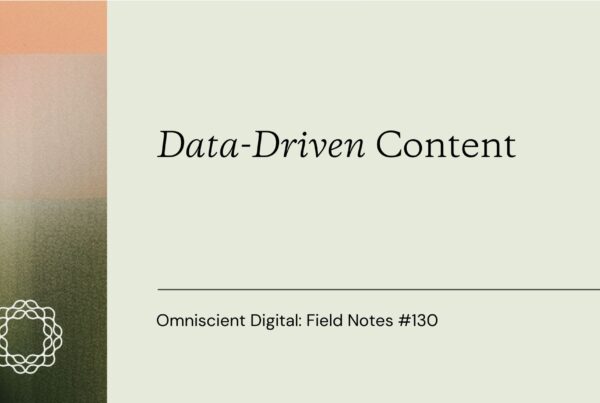
If you’ve been in marketing or SEO for the last decade, you probably noticed how the game has changed.
From 2013 to around 2021, many (but not all) SaaS companies followed a similar playbook. Inspired by HubSpot, everyone went after high-traffic keywords that were only loosely related to their products. And it worked—at least on paper. We saw big traffic gains with top-level content.
Think: “What is CRM?” or “How to do X.”
It was a game of numbers, and it looked good in the quarterly reports. We used to write 10,000 word pillar pages, attempting to build the tallest skyscraper and show our audience (but mostly Google) that we were, indeed, the most deserving of that top spot for keywords like “account based marketing.”
But let’s get real. Did those numbers actually help close deals? Not really. Most of that TOFU traffic was just filling up the numbers but doing little for conversion.
The Traffic Trap: A History Lesson
We call this model the traffic trap.
The goal was simple: pull in as many visitors as possible with high-volume, entry-level content.
Here’s an example: at CXL, our highest traffic page, by a very large margin, was this piece on value propositions (that has since been updated many times).
It ranked for “value proposition,” “what is a value proposition,” “value proposition examples,” etc.
But the majority of those readers were beginners, early-career professionals, or students—people who were nowhere near ready to buy. They weren’t looking for a B2B solution or ready to convert. They just wanted an answer to a basic question to help them pass a business 101 class.
Take HubSpot’s approach as another example. Their content strategy was to rank for everything under the sun, even topics like “shrug emoji” and “famous quotations.” Sure, it brought eyeballs, but was it really drawing in qualified prospects for CRM software? Highly unlikely.
The problem wasn’t necessarily that irrelevant traffic was coming in. In isolation, there’s no real harm in irrelevant traffic.
The problem comes from the incentive structure that forms around aiming towards traffic alone as a goal.
Essentially, once you stake a claim for these irrelevant pages and keywords, the pressure mounts to maintain that volume.
Once TOFU traffic became the metric, companies had to keep that pipeline flowing, even if it meant endlessly pumping out low-intent content and over-optimizing their existing pillar pages to maintain their position. Marketing teams got stuck in a hamster wheel, churning out posts to maintain their numbers, with diminishing returns. That’s a big old opportunity cost in my eyes.
It’s like spending your entire workout doing burpees, an overrated and highly inefficient workout that basically just exhausts you and has low to no benefit for muscle building and is a weak and risky form of cardio (sorry burpees aficionados).
You spend all your time and budget maintaining your position for “motivational quotes,” because if you lose any of that 100k traffic, you’re going to have a disappointing reporting call. Meanwhile, you’re missing a million opportunities to ACTUALLY solve business problems for buyers and through doing so drive meaningful outcomes for your product.
Does any of this sound familiar?
2022-Today: When SEO Strategies Went Through the Blender
Fast-forward to today.
This year alone, SEO has undergone a radical transformation.
Google rolled out broad AI overviews, ChatGPT launched its own search engine, and we’ve seen algorithm changes that knocked scalable TOFU content strategies down a peg. Traffic has declined, but leads? If you’re focusing on the right strategies, they’re stable, maybe even up.
The savvy folks have already shifted their mindset to reflect this new paradigm.
For example, a recent client in the cloud voice space has competitors going after high traffic terms like “212 area code.” This keyword alone gets decent search volume, and if you scale out the pattern to all area codes, it’s millions of potential visitors. But here’s the thing: it mostly attracts casual searchers annoyed by spam calls. Not exactly the target market for an enterprise cloud communications platform.
Instead of chasing those “easy” keywords, our client decided to let irrelevant pages decay. When we asked if they wanted to focus on growing organic traffic, their response was refreshing: “Only if it’s relevant.”
They weren’t interested in TOFU traffic that doesn’t convert. Instead, they aimed to move the needle on qualified pipeline.
This shift in mindset has been game-changing.
The Future of SEO: Specificity Over Scale
As we look forward to 2024 and beyond, SEOs are going to need to change how they think about their objectives and KPIs, in effect, thinking more like product managers and solving for the customer, and end their addiction to irrelevant traffic gains.
AI tools like ChatGPT and Perplexity are changing the game, no matter what your personal beliefs are on these tools.
Instead of Googling “what is SaaS” or “how to do content marketing,” people are turning to AI for specific, nuanced answers. And I get it. I’m doing it myself. Where I once used Google for everything, I’m now using GPT-4 and Claude for those super-specific queries.
This means that broad, “catch-all” content is losing relevance. The customer journey and its entry points are being shaken up.
The value now lies in content that speaks directly to decision-makers and addresses specific pain points. I’d rather dig into our Gong calls and create articles that directly address the needs of a VP of Growth than write another “Ultimate Guide to SEO KPIs.”
Instead of yet another “SEO 101” post, we can connect the dots on real challenges. Imagine a post on how to tie CRM data to web analytics for revenue attribution, written specifically for those who understand SEO’s value but need help proving its impact.
Now that’s content that can drive real value.
Why TOFU’s Decline is a Win for Marketers
Letting go of TOFU traffic is freeing.
It lets us focus on what actually matters: creating meaningful content that resonates with the right audience. The TOFU traffic trap kept us running in circles, but we’re moving into a phase where it’s okay—preferable, even—to let those pages fade.
This isn’t just an SEO change; it’s a philosophical shift.
We don’t need to prop up pages that don’t serve our goals. Instead, let’s pivot to quality content that truly adds value, builds trust, and aligns with our core KPIs, like pipeline growth and lead quality.
So, if you’re seeing a decline in traffic on those broad, entry-level topics, I’d say let it happen. Focus on your ICP’s pain points, tap into the insights you already have from customer calls, and build a content strategy that moves the needle.
The days of TOFU for TOFU’s sake are over, and that’s a win for anyone focused on results over vanity metrics.
So in the paraphrased words an old punk band, “TOFU is suffering? Let it die!”
Want more insights like this? Subscribe to our Field Notes.


